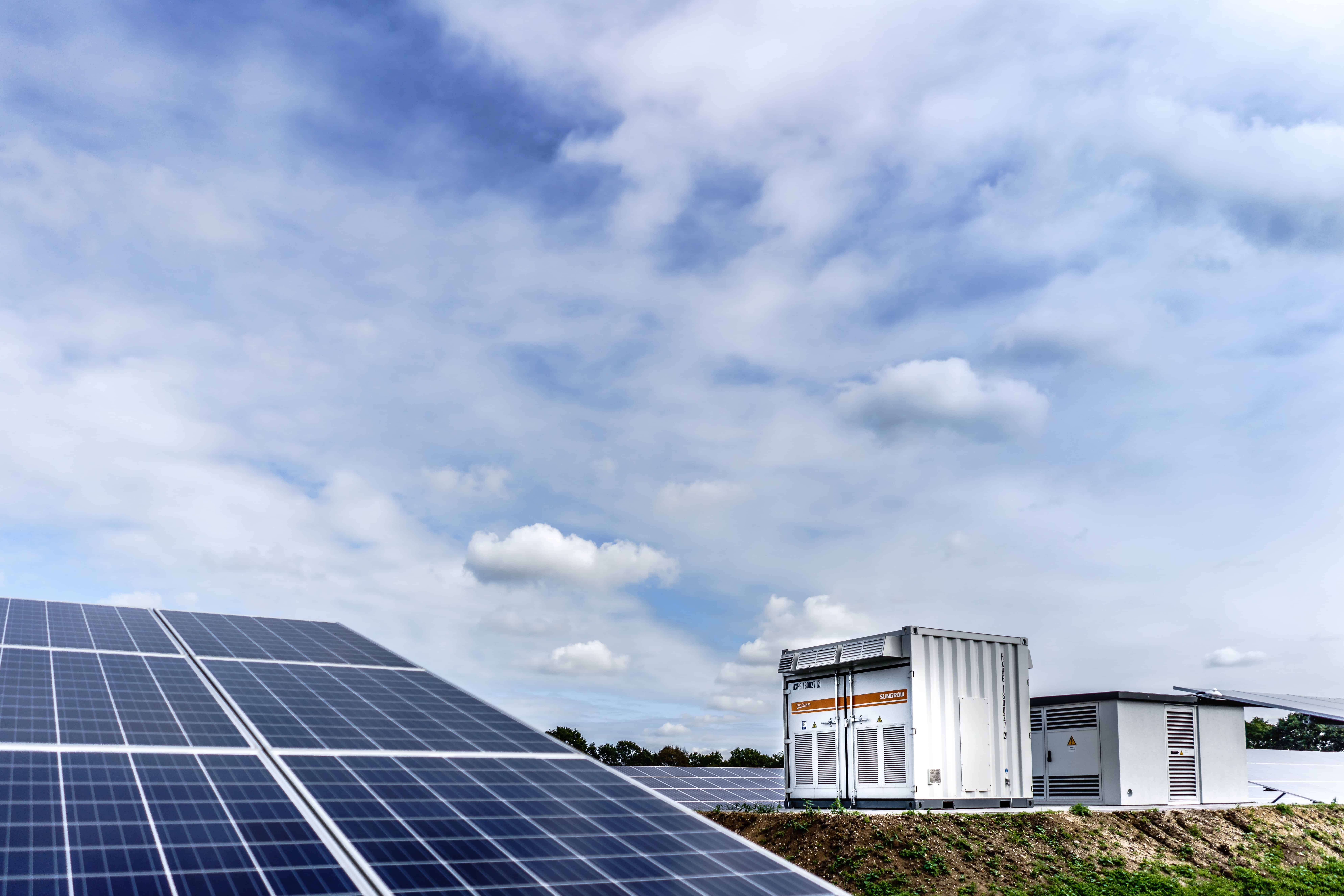13 Jul Renewable Energy Storage in India – Emerging Technology

Large-scale renewable energy storage is a relatively new technology area that has grown rapidly along with demand for renewable energy. The primary drawback of renewable energy is its dependence on weather and inefficiencies in storage for later usage. Lithium-ion batteries are the most widely used battery storage option today and control more than 90% of the global grid battery storage market [1]. Flow batteries present an emerging alternative to lithium-ion batteries.
Renewable Energy in India
At the 26th Conference of Parties (CoP26), India declared a five-fold strategy, termed as Panchamrit [2] to fight climate change. Two of these five-fold strategy include: targeting non-fossil energy capacity to 500 GW and to meet 50% of the country’s energy requirements with renewable energy by 2030.
As of 31st December 2021, the total installed capacity for renewable energy in India is ~151 GW (gigawatt) [3], with Solar (49 GW), Hydro (46 MW) & Wind (40 GW) accounting for ~90% of the total renewable energy.
For achieving its renewable energy targets the government has launched a Production Linked Incentive (PLI) [4] Scheme called “National Programme on High Efficiency Solar PV (Photo Voltic) Modules”. This scheme outlays USD 580 million for incentivizing domestic manufacturing of Solar PV modules and insulating the solar industry from disruptions in global supply chain.
Storage Challenges for Renewable Energy in India
A major roadblock for making renewable energy practical and dependable has been the storage of the generated electricity. The search for a reliable grid-scale energy storage technology is still on. The batteries used for this application are still quite expensive, and they are large. The more power you need, the larger the battery requirement will be.
Suitable Energy storage provides the power system with flexibility and is useful in increasing the volume of renewable power that can be connected safely and securely to the grid. Hence, significant efforts are being globally made to address the challenges faced in storage of renewable energy.
Redox Battery – Emerging Energy Storage Technology
Operating Mechanism [5]
Redox Flow Batteries (RFBs) get charged and discharged by means of the oxidation–reduction reaction of ions of Zinc-Bromine, Vanadium , Polysulfide–bromine etc. The energy is stored in two liquid electrolytes in separate tanks. When charging is done, the energy supplied ensures that electrons from the electron-poor side move to the electron-rich side, creating a potential difference. During discharge, the reverse happens — electrons flow from the electron-rich side to the electron-poor side. The flow of electrons is electricity.
The conversion of energy from chemical to electrical happens in a cell, which is split into two half-cells by a membrane. Electrolytes are required to allow the flow of electrical charge between the cathode and anode.

Figure 1. Zinc-Bromine Flow Battery [6]
Advantages of Flow Battery
Flow batteries bring significant advantages including being modular. The energy storage capacity can be increased by simply raising the volume of the electrolyte tanks. If more power is required, it is necessary to increase the number of membrane stacks. Secondly, power can be stored for long durations, which is significant for the seasonal wind and solar industry.
These have a long service life with almost no degradation of electrodes and electrolytes, high safety due to their being free of combustible materials, and availability of operation under normal temperatures.
Types of Redox Flow Battery
Several types of Redox Flow battery exist such as Zinc Bromide, Vanadium, Polysulphides, Zinc-Cerium etc. However, researchers claim that Vanadium redox flow batteries (VRFBs) and zinc-bromine redox flow batteries (ZBFBs) are the most promising flow batteries.
As can be seen in Figure 2, Zinc Bromide flow battery has among the highest energy density among other batteries making it very compact and efficient.

Figure 2. Key Parameters of Different Energy Storage Batteries [7]
Redox Battery – Status in India
Research Stage :
Zinc-Bromine RFB [8]
India’s Council of Scientific and Industrial Research (CSIR) has been involved in the development of Zn-Br (Zinc Bromide) Redox Flow Batteries for more than a decade. Zinc bromine redox flow battery of 500 Watts have been developed by CSIR. Research is ongoing to scale up the development for a grid-level energy storage to a Megawatt level which will reduce the energy storage costs by up to half in the country.
Vanadium RFB [9]
In September 2020, researchers from IIT Madras developed a Vanadium RFB which can be directly deployed in industrial-scale stacks for grid-level storage. The storage system has a rated power capacity of 5 kW and 8 kW of peak power, with 25 kWh of storage capacity. The storage capacity can be increased by increasing the volume of the electrolyte in the reservoirs or by adding new reservoirs while maintaining the same number of stacks. Similarly, if the power rating needs to be increased, more stacks can be connected to the same reservoirs.
Zinc-Iron RFB [10]
In August 2021, Indian Researchers from Christ College, Kerala have developed a dendrite-free zinc-iron redox flow battery. Dendrites are filament-like spikes, or extrusions, that could create short-circuit by connecting the two electrodes and giving the electrons a less-resistance pathway.
The abundance and relatively lower costs make zinc a viable option to commercialize the production of the redox battery. According to the researchers, this technology has overcome serious drawbacks of previous technologies by achieving homogeneous zinc coatings and no dendrite growth on zinc electrodes after repeated charge and discharge cycles.
Lead RFB [11]
Researchers from IIT Madras have developed a lead-based flow battery. The use of lead in energy storage is age-old and the lead-acid batteries are ubiquitous. However, in the ‘soluble lead redox flow batteries’, the big challenge was the growth of dendrites.
The IIT Madras researchers have been able to “successfully circumvent” the dendrite growth problem and are now looking for funding for a pilot plant.
Commissioned Stage:
BHEL commissioned a Vanadium based redox flow battery in 2018 which provides 50 kW of power with capacity to store 200 kWh of energy in a period of four hours.
Key Take Aways
Globally, there are a few sites which have started using Bromine flow batteries in stationary storage applications for grids. However, commercialization has not happened at a global scale and significant research is being carried out globally. India’s research investments in this field are notable. The outcome of the Zinc Bromide RFB research being carried out by CSIR can provide a huge growth impetus to the industry as this type of flow battery has among the highest energy density, making it very compact and efficient.
This technology stores energy directly in the electrolyte solution for longer cycle life and quick response times. Flow batteries are in early stages of commercialization compared to other battery technologies; however, their long life cycles, higher depth of discharge, and easy scalability offer advantages over other systems.
Given the increasing demand for renewable energy in India, commercialization of feasible energy storage technologies is expected to be see an uptrend. This would pave a way for smooth renewable energy transition in the county.
Source:
- https://www.nrel.gov/docs/fy21osti/78101.pdf
- https://pib.gov.in/PressReleseDetail.aspx?PRID=1768712
- https://www.investindia.gov.in/sector/renewable-energy#:~:text=India’s%20installed%20renewable%20energy%20capacity,as%20on%2031st%20December%202021
- https://www.pib.gov.in/PressReleasePage.aspx?PRID=1710113
- Flow Batteries for Power Storage System, Nandini Chemical Industry Insights
- https://www.semanticscholar.org/paper/The-Zinc%2FBromine-Flow-Battery%3A-Fundamentals-and-for-Rajarathnam/aa45f0d61da0aff3cf516de014c5a1cd3889cebe
- Redox Flow Battery for Energy Storage, Toshio SHIGEMATSU
- https://www.indiascienceandtechnology.gov.in/research/high-energy-density-low-cost-and-environmentally-benign-redox-flow-batteries-bulk-storage?field_area_id=4745
- https://www.pv-magazine.com/2020/09/16/vanadium-redox-flow-battery-for-storage-of-wind-and-solar-power/
- https://www.saurenergy.com/solar-energy-news/indian-scientists-make-dendrite-free-zinc-iron-redox-flow-battery
- https://www.thehindubusinessline.com/business-tech/can-flow-batteries-support-indias-renewable-energy-pivot/article65347708.ece




No Comments